Top Plants: San Cristobal Wind Project, Galapagos Islands, Ecuador
Owner: San Cristobal Commercial Trust Operator: EOLICSA-Elecgalapagos
The Galapagos Islands, home of the unusual flora and fauna that inspired naturalist Charles Darwin’s groundbreaking work on evolution, are striving to promote clean energy that protects the area’s unique biodiversity. Part of that effort is the 2.4-MW San Cristobal Wind Project, which displaces diesel-powered electricity generation. This new energy source will cut greenhouse gas emissions and reduce the risk of devastating diesel-fuel tanker spills in a highly protected environment.
Nicknamed the "Enchanted Islands" because of their stunning scenery, the Galapagos Islands are renowned for their large number of endemic species and the studies by English scientist Charles Darwin that contributed to the inception of his theory of evolution by natural selection. The Galapagos Islands, which are an Ecuadorian province, form an archipelago 600 miles off the coast of Ecuador and consist of 13 major islands, six minor islands, and approximately 40 smaller rock formations scattered throughout 17,000 square miles of ocean. The Galapagos Islands are well known as a worldwide treasure housing a rich diversity of land and marine life from iguanas, sea lions, and giant tortoises to penguins, flightless cormorants, and colorful tropical birds.
The San Cristobal Wind Project is the first stage of a program supported by Ecuador, the United Nations Development Programme (UNDP), and some of the world’s largest electricity companies. U.S. utility American Electric Power (AEP) led the wind energy project on behalf of the "e8," a group of 10 power companies from around the world that promote sustainable energy development by working with local power companies, communities, and governments to build electricity generating and transmission projects. Paul Loeffelman, AEP director of environmental public policy, has been the project’s team leader since its inception (Figure 1).
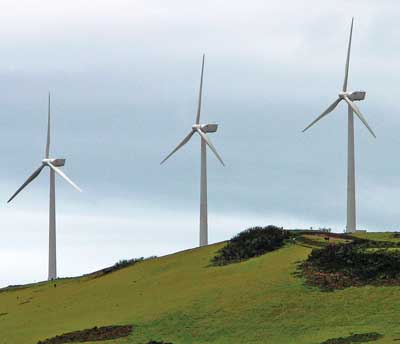
1. Triple-hitter. The three 800-kW wind turbines, which generate 2.4 MW of clean energy, constitute the first large-scale wind project in Ecuador. Courtesy: American Electric Power
Powering paradise: The move to renewable energy
In January 2001, the fuel tanker Jessica hit a reef and began breaking up in the midst of the Galapagos Islands and spilling an estimated 75,000 gallons of fuel oil and 70,000 gallons of diesel into the pristine environment. Even though a number of birds and other wildlife had to be cleaned by rescue volunteers, meteorological conditions and relatively quick action by a number of response teams, including the U.S. Coast Guard, to control the spill lessened the damage. However, the incident triggered an international initiative to cut the risk of future oil spills by reducing the area’s dependence on diesel fuel to generate electricity.
To that end, the UNDP undertook a resource assessment and feasibility study to promote the goal of bringing renewable energy to the Galapagos Islands. Different renewable strategies were proposed for each of the four inhabited islands of the Galapagos. San Cristobal Island, whose highland hills sit perpendicular to the prevailing ocean winds, was determined to have better wind resources than solar resources. The San Cristobal wind resource can be said to be good, but it would probably not be considered economical for a normal mainland grid-connected system in the U.S. or Europe. The final wind project site selection balanced wind resource, construction access, and the need to avoid nesting and flight areas of the endangered Galapagos petrels. Even with these constraints, the wind project was projected to deliver 50% of the island’s electrical demand on an annual basis and to be a cornerstone of the Ecuadorian government’s goal of making the Galapagos Islands 100% petroleum free.
"This outreach effort represents part of AEP’s perspective on sustainability and a global energy future — we’re providing developing countries with real solutions to attain the basic comfort that electricity provides, while at the same time addressing climate change and environmental issues," said Mike Morris, AEP chairman, president, and CEO, in March 2008 when the San Cristobal Wind Project was dedicated. "It is an excellent illustration of leadership in environmental and technological innovation, public-private partnerships and engagement in the global climate change policy discussion."
The project’s innovative financing included funding from the UN Foundation, UNDP, Ecuadorian taxpayer-directed (check-off) donations, the government of Ecuador, and the e8 companies. The largest contributions came from Ecuador, which provided more than 30% of the project’s funding, and AEP, which provided nearly half of the project’s approximately $10 million cost. However, AEP and the other e8 partners do not make profits from the financial and human resources they invested in this project. "Our strategy is for these partnerships to lead the way for many commercial projects supported by the host country and power companies," Loeffelman said.
A Darwinian feat: Surviving the permitting process
Due to its location in the Galapagos Islands, which are a UN-designated World Heritage Site, the San Cristobal Wind Project had to undergo an extensive permitting and approval process with the Ecuadorian government. First, the conceptual project had to be approved by the National Institute for the Galapagos (INGALA), a council that approves regional development projects. Then, joint approval was required by the Ministry of Environment and the National Electricity Council (CONELEC) in order to secure the environmental license for the wind project. The project team also had to perform a detailed environmental impact assessment (EIA), with stakeholder input from local communities, other government agencies, and several environmentally focused nongovernmental organizations.
The wind project was the first power project in Ecuador to undergo a new process of public participation in preparing the terms of reference for the EIA and its eventual approval. Due to the high-quality EIA performed and strong public support for renewable energy projects on the Galapagos Islands, the environmental permit was approved and issued by the Ministry of Environment. Next, the Municipality of San Cristobal approved the construction permit.
The regulations from different government agencies on environmental matters were in some cases contradictory or demanded duplicate work (CONELEC vs. Ministry of Environment). In some cases, the wind project required approval under new regulations, such as the tariff or the allocation of rural electrification funds for renewable energy projects. At other times, guidelines for a specific approval process were vague. By taking a rigorous approach in the permitting process and ensuring full transparency, the San Cristobal project helped establish a path for other renewable energy projects in Ecuador to follow.
The main political hurdle encountered by the San Cristobal Wind Project was related to the very frequent rotation of high- and mid-level authorities in the federal agencies that handled environmental and energy issues during the project’s development phase. There was high turnover of government officials during a period of low government stability in Ecuador when several presidential administrations did not complete their respective elected terms in office. Turnover in key positions even went as far as the level of the wind project’s main partner, the local electricity utility, Elecgalapagos. The project team had to meet with the frequently changing governmental officials to brief them on the wind project, its objective, and current status. Fortunately, it should be emphasized, that in spite of the frequent change of officials, all written agreements previously obtained by the project were respected by later governmental authorities. In general, all agencies of the Ecuadorian government were supportive of a well-planned renewable energy project in the Galapagos.
Project implementation
To initiate the project, the e8 prepared a feasibility report and approved it in February 2005. That report identified a baseline system of three 660-kW wind turbines with a total capacity of 1,980 kW; the plan included a battery energy storage system coupled with the existing diesel generator plant.
The project team held a competitive bidding process for supply and construction of the wind project. The final configuration of wind turbines (manufacturer, kilowatt rating, quantity, blade diameter, and rpm) was selected based on market offerings at the time of the construction tender. Project leaders selected MADE, a manufacturer based in Spain, to supply the wind turbines and controls plus automation of the existing diesel generators, and Santos-CMI of Ecuador to handle project construction and be the logistics coordinator.
The selected system included three 800-kW variable-speed, synchronous wind turbines but no energy storage provisions. Three 650-kW diesel generators from the existing system were reconfigured to benefit from automated controls. A control system was designed to dispatch the wind turbines and diesel generators in hybrid mode, ensuring adequate power supply and quality to meet San Cristobal’s demand for electricity.
The 800-kW wind turbines (Figure 2) are MADE Model AE59 with 59-meter-diameter (194-foot) blades and a hub height of 51.5 meters (169 feet). The turbine blades were optimized for the wind characteristics of the Galapagos Islands (Figure 3).
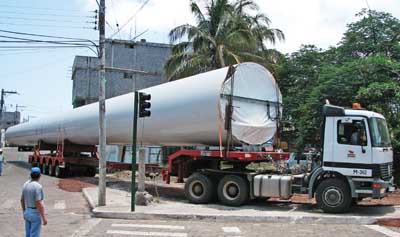
2. Tight squeeze. Many special arrangements were required to move the heavy turbine parts through the streets of San Cristobal from the harbor to the hill top. Courtesy: American Electric Power
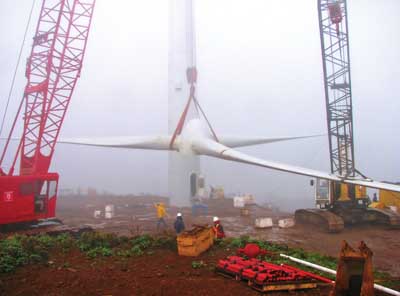
3. Lift off. Three long blades, three tons and 29.5 meters (97 feet) each, were assembled and lifted 51 meters (167 feet) to be placed at the top of each tower. Courtesy: American Electric Power
An electrical "collector" system gathers power from each wind turbine through underground cabling and transports it down the hillside to the wind park boundaries, where it interfaces with a transmission line. Leaving the wind park, the first 3 km of the line run underground to minimize the possibility of collision between the line and the endangered Galapagos petrels. The transmission line then converts into an aerial conductor for approximately 9 km before tying into the current distribution system at the diesel plant.
The construction crew built a new control building adjacent to the existing Elecgalapagos diesel plant control room area. The control building contains a control room, an archives room, and an office for the wind project’s operations management team.
Provisions in the contract signed with MADE included remote monitoring and troubleshooting of the wind turbine equipment via Internet by MADE staff in Spain. Although originally envisioned in the feasibility study, the energy storage provisions were not implemented due to maintenance and environmental considerations. Although the wind turbines frequently generate more energy at night than the island’s power company requires, excess energy cannot be captured and stored for later dispatch with the current system. Plug-in vehicles and energy storage may be considered for the project in the future, as battery and other technologies are improved and become more cost-effective.
In addition to the three wind turbines, the facility includes two 6-kW solar photovoltaic systems. To promote the efficient use of this solar energy source, the facility offers technical operations and maintenance (O&M) training and energy efficiency educational programs for residential customers.
The three wind turbines belong to one of the largest wind-diesel hybrid systems in the world and could supply more than 50% of the island’s electricity needs. The system, which took about five years to plan and a year to build, avoids approximately 2,800 tons of carbon dioxide emissions annually from diesel generators. In addition, by displacing the use of diesel with wind, the project cuts the risk of diesel fuel spills in the environmentally fragile Ecuadorian archipelago.
O&M overview
In accordance with Ecuadorian electric sector laws, a corporation (Sociedad Anónima as per Ecuadorian Law) was established to operate the San Cristobal Wind Project. This corporation is referred to as Eólica San Cristobal S.A. (EOLICSA). The Commercial Trust is EOLISCA’s primary shareholder, along with the national utility, Elecgalapagos. In time, all shares of EOLICSA will be transferred to Elecgalapagos.
The project’s current operations manager resides on San Cristobal and is responsible for on-site operations and technical hands-on training. In order to maintain a flat and economical organizational structure and ensure effective technical monitoring, a strategic O&M contract was signed with MADE for a two-year period. Under this contract, MADE provides a full-time representative on San Cristobal to assist with O&M of the wind project’s hybrid system. Additionally, through secure Internet links to the wind project’s control system, MADE experts in Spain are able to monitor or operate the project’s equipment and obtain data for maintenance and troubleshooting activities. EOLICSA also intends to reach agreement with Elecgalapagos for O&M and repair support of the turbines.
Instead of manually operating and dispatching the existing diesel generators, the staff controls them via computers, from the new hybrid control system. That system can run in automatic mode, dispatching wind turbines and diesel power according to power demand on the one hand and the availability of wind energy on the other.
A successful first year
The San Cristobal Wind Power Project started its commercial operation on October 1, 2007. Some detailed setup actions were conducted in the control system in order to properly coordinate the wind farm’s operation with the existing diesel units for automatic operation mode.
Generally, actual wind conditions during the operation period have been 30% lower than historical and forecasted values, so the power generated has been below expected values. According to the Ecuadorian National Meteorological Institute (INAMHI), similar lower wind conditions prevailed on the Ecuadorian mainland and across much of South America. Normal conditions are expected to return by the end of 2008.
During the first 12 months the project has been on-line, the wind turbines have operated properly, without significant issues. Only minor corrective maintenance was required. Programmed bimonthly preventive maintenance activities were conducted as scheduled. Routine annual maintenance will be conducted in December 2008.
The wind farm’s availability has been 94%, which has required only a single diesel engine to operate. For the first full year of operation, the amount of wind energy was 30.8% of the total energy delivered. But there was wide variation: April was 6.2% while September was 53.5%. Total wind energy delivered during the operation period was 2,543 MWh, equivalent to 2,034 tons of CO2 emissions avoided.
During the wind project’s first year of operation, wind generated roughly 30% of the total power generated on the island. In contrast, under normal wind conditions, wind energy is projected to contribute approximately 50% annually. During the seasonal high-wind period, which is October through December, the turbines are expected to generate 70% to 80% of the island’s electrical demand. Total wind power delivered during the operation period was 2,543 MW, equivalent to 2,034 tons of CO2 emissions avoided.
The project management team has taken special care to follow all recommendations of the environmental management plan approved along with the environmental license, especially the program to protect the endangered petrels. Ongoing bird monitoring at the site shows that no birds have been negatively affected by the wind project. In fact, early indications are that higher numbers of young birds are hatching successfully (Figure 4).
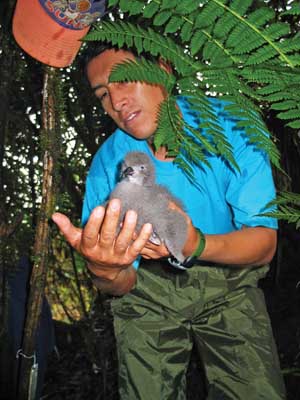
4. This is for the birds. In order to protect the indigenous endangered petrels, the project team took measures to minimize the project’s impact on the birds, such as controlling adverse invasive species and predators and conducting long-term monitoring of the birds’ well-being. Courtesy: American Electric Power
Energy invoices under the power purchase agreement have been regularly paid by the single client, Elecgalapagos. Despite lower-than-expected generation due to wind conditions, the payments cover the project’s operating budget. The rate that end users will pay is regulated by the national electricity council and will not be affected by the start-up of this plant.
Future evolution of renewables
The wind project is expected to significantly reduce San Cristobal’s consumption of diesel fuel. Modeling of the hybrid system using the U.S. National Renewable Energy Lab’s (NREL) internationally recognized HYBRID2 computer model indicates that the annual performance levels shown in the table will be achieved.
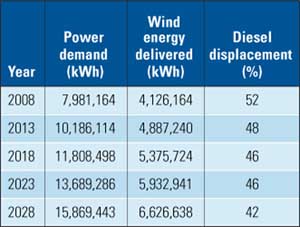
Displacing diesel. The project’s goal is to replace diesel power with increasingly higher levels of wind energy. Source: American Electric Power
The San Cristobal Wind Project is seen as the first stage of an umbrella program supported by Ecuador and the UNDP that will eventually bring renewable electricity — hybrid wind-diesel plus some photovoltaic — to the 25,000 residents of the Galapagos archipelago’s four inhabited islands.
"The project is currently being replicated by the government and UNDP on the island of Baltra and nearby Santa Cruz, the most populated island in the Galapagos," said Loeffelman. "Features like the petrels protection program, the development of the EIA, the treatment of the transmission line issues, the wind data collection, the selection of equipment, etc. are being guided by the San Cristobal Wind Project’s previous experiences. The ultimate goal of Ecuador and UNDP is to make the Galapagos Islands 100% free of petroleum imports by the year 2015."
The wind farm is also a model for the global promotion of small-scale renewable energy power generation and distribution systems in remote areas, and the UN has publicized the effectiveness of the public-private sector partnership to its member countries to reduce global greenhouse gas emissions. The San Cristobal Wind Project management team has been transparent in sharing its technical information, project approach, and detailed cost data with the government of Ecuador and the UNDP. The project should serve as a baseline reference for other hybrid wind systems for islands or remote power grids throughout the world (Figure 5).
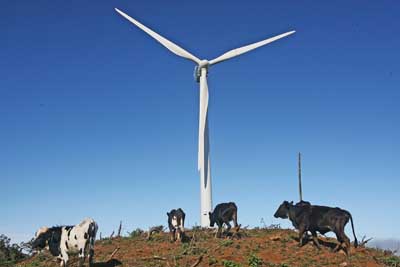
5. Good neighbor. The San Cristobal Wind Project does not interfere with the site’s being used as pasture land for dairy cattle. Courtesy: American Electric Power
According to Pedro Zapata Rumipamba, mayor of San Cristobal, the locals strongly support this wind project. "The perception the islands’ inhabitants have of the Archipelago’s administration, as well as this municipality, is basically related to adequate resource management for the sustainability of the Galapagos Islands, and of Isla San Cristobal in this case," he said. "We will take ownership of this project and work to support its future sustainability."
Darwin once said, "It is not the strongest of the species that survives, nor the most intelligent; it is the one that is most adaptable to change." Through their willingness to embrace the next generation of power generation, the people of the Galapagos Islands appear to be well on their way to successfully surviving in the 21st century.